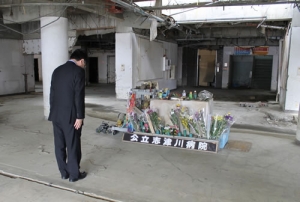3/11, Disaster Medicine, & ToMMo: Perspectives from the Executive Director (Part 3 of 4)
Nicole Gunawansa | November 25th, 2015
This interview was held on May 25th, 2015 in the Tohoku Medical Megabank Building
Part 3- The Megabank Business: Understanding Genome Based Medicine
Question 7: How do you envision genomic research promoting disaster recovery of the Tohoku region?
Dr. Yamamoto: Genome-based medicine is the future of medicine as it will lead to more precise diagnosis, more effective preemptive efforts, and overall improved personalized healthcare. Developing an understanding of the 'blueprint' of our bodies, reflective of genomic information, allows for physicians and the medical community to provide individualized treatment. Although genome analysis is fairly recent, it is quickly expanding field and soon participants will be able to receive useful data about the ideal method of maintaining their personal health. Additionally, establishing an innovative research development center in Sendai has boosted the job environment after 3/11. Sendai is becoming a center of scientific industry and education, following the path of other cities which have made economic transitions in the aftermath of disasters (e.g. Kobe after the Great Hanshin Earthquake).
Question 8: ToMMo endorses personalized medicine for community members/participants. What is the current policy on returning personal genomic data? For example, will ToMMo inform participants if they carry the gene for a degenerative disease?
Dr. Yamamoto: As of right now, no one had a good answer to this question. The rule and regulations for this ethical dilemma are still under development. At this point, ToMMo is not returning genome analysis information to participants, but we are in the process of determining a protocol for this transaction. Many committees are being formed and soon an advisory panel with specialists in Japan will be consulted to decide how to handle this sensitive issue. Nevertheless, we hope to return useful information to patients to prepare and protect them from preventable diseases.
Question 9: ToMMo is the first megabank in Japan to include mental health services for patients. What was the basis for the inclusion of mental healthcare in ToMMo?

Dr. Yamamoto honoring the lives lost at Shizugawa Public Hospital*, which was destroyed during the disaster.
Dr. Yamamoto: The Great East Japan Earthquake was devastating, and the subsequent tsunami delivered a crushing, crippling blow to the people of the Tohoku region. As a result of the horrendous event, the prevalence of Post-Traumatic Stress Response (PTSR) and other types of mental diseases dramatically increased. The emotion and mental turmoil survivors experienced after 3/11 is natural, and echoed the mental health situation following the 2004 Indian Ocean Earthquake and Tsunami. We recognized that these cognitive, psychological health concerns were serious, limiting the livelihoods and welfare of the people it affected, and so we were determined to include mental health in our ToMMo framework. Although some people are beginning to forget about those who suffered great hardships and loss due to the disaster four years ago, the mental troubles/disease survivors experience are still present and still difficult to cope with. These are the people ToMMo is aims to support in their journey of recovery, especially as time moves forward and memory of the disaster begins to fade.
*After almost five years, reconstruction of Shizugawa Public Hospital will finally be complete in December (2015). Although the hospital is being relocated to the next town, it is a relief that the people in the coastal area will now be able to receive treatment closer to home.
Related Link
To Place Seeds of "Hope" in Tohoku Now (Interview from ToMMo's public magazine "phrase" Vol.1)
